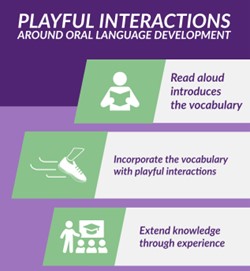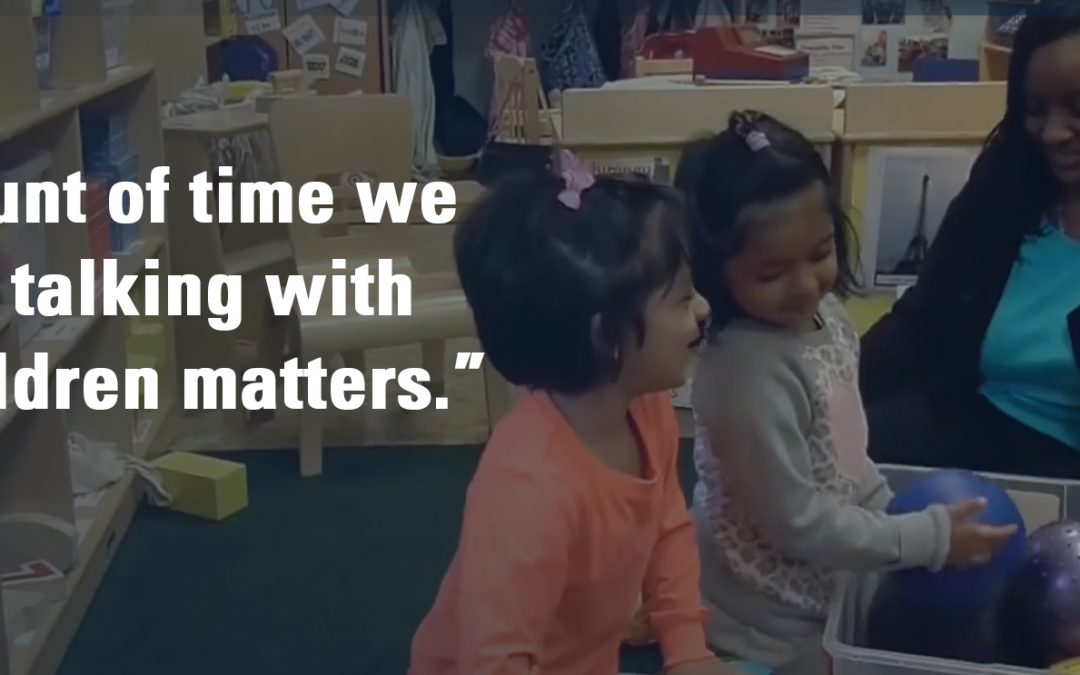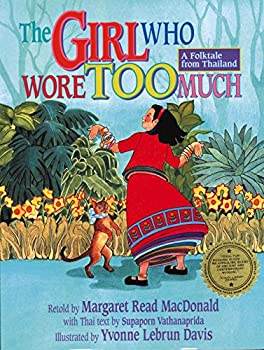By Michelle Cianciosi-Rimbey and Kristin Klingensmith with Michael Telek
Calls for ensuring that purposeful play is a critical component of early childhood classrooms have been made by researchers and educators (Hadley & Newman, 2022; Allee-Herndon & Roberts, 2021; NAEYC, 2022). Zosh and her colleagues (2022) present purposeful play on a spectrum, ranging from self-directed play, guided play, playful instruction, and direct instruction. These types of play mainly highlight the degree of adult guidance, child autonomy, and the presence of learning goals. What we consider here is a focus on a high degree of guidance from teachers with clear learning goals in the areas of math and literacy instruction.
A critical component of purposeful play is engaging children in talk. The amount of time we engage in talking with young children matters. Research shows that the number and quality of the conversations that adults have with young children directly affects how they learn to talk (Shonkoff & Phillips, 2000). The number of total words, and the variety of words that parents and adults use with the child on a daily basis, the number of conversations and discussions, and the number of positive affirmations are related to language development (Hart & Risley, 1999).
In addition, oral language development is considered an unconstrained skill. In other words, it is a skill that can never be fully mastered because there is always more to learn.
IFL fellows share four strategies for embedding productive talk into purposeful play.
-
- Expect a Talking Community
- Find Out Their What and Why
- Show and Discuss
- Go with Their Flow
These strategies can be used to spark, strengthen, and enhance language skills that positively impact learning for each and every student.
Expect a Talking Community
An expectation that talk is used to explore and explain ideas is essential in supporting young children in language development, as well as conceptual understanding. Teachers can provide opportunities for children to listen to and respond to one another by repeating back what was said, putting what was said in their own words, and adding on to what was said. Teachers can also provide opportunities for students to make and support claims and offer counter ideas.
Students should be welcome to use the language that they use at home while at school to communicate their ideas. Whether a student is acquiring English as their only language or as an additional language, hearing, saying back, saying it another way, helps build and strength their oral language.
Approaching learning through talk allows children the much-needed time to process new ideas and information and integrate them into their existing thinking. Often, children need time to verbally make sense of and articulate their thinking with the community of learners who are also engaged in the same experience and journey.
Dramatizing Events in a Read-Aloud
The first example of incorporating purposeful play involves a read-aloud of the picture book, The Girl Who Wore Too Much: A Folktale from Thailand. In the book, a girl who is getting ready to go to a dance cannot decide which of the many dresses and jewels she should wear to a dance. She decides to wear them all and learns a valuable lesson. After the teacher read the story, she placed costume jewelry and clothing in the dramatic play area in the classroom. She encouraged children to visit the area later in the day to recreate the events in the story which generated excitement and interest among her learners. This activity encourages students to retell the story through dramatic play, as a way to support their comprehension of the text and encourage verbal interactions among their peers.
Find Our Their What and Why
An expectation that talk is used to explore and explain ideas is essential in supporting young children in language development, as well as conceptual understanding. Teachers can provide opportunities for children to listen to and respond to one another by repeating back what was said, putting what was said in their own words, and adding on to what was said. Teachers can also provide opportunities for students to make and support claims and offer counter ideas.
Students should be welcome to use the language that they use at home while at school to communicate their ideas. Whether a student is acquiring English as their only language or as an additional language, hearing, saying back, saying it another way, helps build and strength their oral language.
Approaching learning through talk allows children the much-needed time to process new ideas and information and integrate them into their existing thinking. Often, children need time to verbally make sense of and articulate their thinking with the community of learners who are also engaged in the same experience and journey.
Conservation
In this video, students were playing at the water table and the teacher joins them and begins engaging them in a conversation about how the 1 cup of water looks different but doesn’t change in volume when it is placed in different containers.
The video focuses on conservation of volume an idea related to the conservation of quantity and linear measurement. Through multiple cognitively engaging experiences, students had an opportunity to develop, revise, and refine their thinking and reasoning related to conservation. Through these experiences, students also had several opportunities to further develop their use of verbal-language when sharing their thinking and reasoning. The combination of experiences and discussion lay the foundation for a fully developed understanding of conservation which can take years to establish.
Show and Discuss
Pictures, images, charts, and manipulatives all serve as scaffolding tools for understanding concepts and language. This strategy allows the visual representation, in this example manipulatives, to serve as a scaffolding tool that helps guide and shape understanding through discussion, rather than as a product of the child’s understanding.
Playful Interactions around Oral Language Development
During our discussion of robust vocabulary instruction with coaches, they described how teachers incorporate playful interactions with sophisticated language for their youngest learners. One story that shared involved the word “exhausted.”
After children learned the meaning of the word, exhausted, through a read-aloud the teacher incorporated playful interactions with the word throughout the school day. An example of one of these interactions included the teacher taking students to the playground and asking them to run as fast as possible. When the students returned to the classroom, she asked them how they felt as they collapsed on the floor. This playful interaction cemented students’ understanding of the word, exhausted, not only because they experienced how it felt to be exhausted, but because the conversation that took place following their rigorous run around the playground, provided opportunities to extend their knowledge about the word while building their oral language development. The teacher posed questions such as, “How does this experience connected to the word, exhausted? How do you feel when you’re exhausted?” These thoughtfully planned interactions with words across a variety of contexts supported children’s learning.

Go with Their Flow
Staying on topic is an incredibly valuable skill, and one that teachers can use to support children’s language development and engagement in discussions. When teachers take language turns with young children and stay on the same topic, children are significantly more likely to reply than if the teacher responds but changes the topic (Dunham & Dunham, 1996). This strategy makes use of a child’s prior knowledge and allows the child to elaborate on topics that interest them in the moment because the teacher’s semantic elaboration supports the likelihood of the child to stay on topic and engage in more language related to the topic. This strategy is especially useful in less structured learning opportunities but can also be utilized in more formalized learning situations because it honors the child’s thinking pathway.
Sorting and Categorizing
The students in this video had been exploring sorting and categorizing in mathematics and had engaged in activities focused on matching by single attributes, then sorting by those attributes, and finally sorting and categorizing by two or more attributes. They had experience sort, resorting, and sub-sorting by color, size, and shape.
In this video, the students and their teacher were in a play center with a bin of balls. The teacher asks them what they can do with the balls and one of the students responds with “sort them.” The video shows the student sorting the bin of balls by color. At one point in the video, the teacher turns to another adult in the room and asks for the word “blue” in Bangla and then uses it to engage a Bengali student in the group. The students also decide to resort the balls according to their size. Throughout the activity students, including those whose primary language is not that of instruction, have opportunities to make claims, give justifications, and debate where to put a multi-colored ball.
For more information related to supporting and engaging English learners, check out these resources.
- “Esto Si lo Puedo Hacer!”: Creating Opportunities for Success when Teaching Academic Vocabulary in Mathematics
- 4 Effective Communication Strategies in Multilingual Math Classrooms
- Engaging in Meaningful Accountable Talk ® Discussions with Emergent Multilingual Students
- In Their Own Words: How Teachers Can Incorporate Students’ Native Language Into The Classroom
References
Allee-Herndon, K. A., Roberts, S. K., Hu, B., Clark, M. H., & Stewart, M. L. (2022). Let’s talk play! Exploring the possible benefits of play-based pedagogy on language and literacy learning in two Title I kindergarten classrooms. Early Childhood Education Journal, 50(1), 119–132. https://doi.org/10.1007/s10643-020-01141-6
Allee-Herndon, K. A., & Roberts, S. K. (2021). The power of purposeful play in primary grades: Adjusting pedagogy for children’s needs and academic gains. Journal of Education, 201(1), 54-63. https://doi.org/10.1177/0022057420903272.
Dunham, P. & Dunham, F. (1996). The semantically reciprocating robot: Adult influences on children’s early conversational skills. Social Development, 5(3), 261-274. DOI: 10.1111/J.1467-9507.1996.Tb00085.X
Hadley, E. & Newman, K. (2022). Prioritizing purposeful and playful language learning in Pre-K. The Reading Teacher, 76(4), 470-477. https://ila.onlinelibrary.wiley.com/doi/10.1002/trtr.2161
Hadley, E., Newman, K. & Mock, J. (2020). Setting the stage for TALK: Strategies for Encouraging Language-Building Conversations. The Reading Teacher, 74(1), 39-48. https://ila.onlinelibrary.wiley.com/doi/abs/10.1002/trtr.1900
Hart, B. and Risley, T. R. (1995). Meaningful differences in the early experiences of young American children, Baltimore, MD: Paul H. Brooks Publishing.
Hart, B. and Risley, T. R. (1995). The social world of children learning to talk, Baltimore, MD: Paul H. Brooks Publishing.
Shonkoff, J. P., & Phillips, D. A. (Eds.). (2000). From neurons to neighborhoods: The science of early childhood development. National Academy Press.
Zosh, J. M., Gaudreau, C., Golinkoff, R. M., & Hirsh-Pasek, K. (2022). The power of playful learning in the early childhood setting. In NAEYC (ed.), Developmentally Appropriate Practice in Early Childhood Programs Serving Children from Birth Through Age 8, 4th ed., 81–107. Washington, DC: NAEYC. Retrieved from https://www.naeyc.org/resources/pubs/yc/fall2022/teachers-questioning-math-learning


